By Steve McKenna
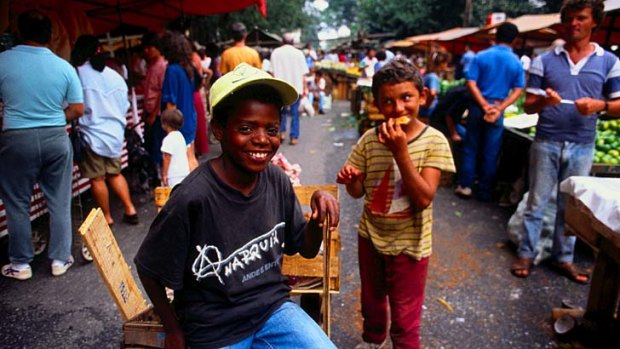
Children in a street market ... Sao Paulo both bucks and confirms Brazilian stereotypes.Credit: Getty Images
From cathedrals and museums to seaside escapes, this is the best on offer in Sao Paulo, Brazil.
1 It's Brazil's cultural and economic powerhouse
Sao Paulo - Sampa to locals - lacks the obvious pull of that famous Brazilian city by the sea (clue: its initials are RDJ), but it's a magnet for overseas visitors. Many visit on business because this hub of finance and industry is the driving force behind Brazil's booming economy (now the sixth largest in the world). Yet South America's biggest metropolis isn't all about hard graft. With its cosmopolitan neighbourhoods, world-class museums and culinary flair, along with samba beats and shanty towns, Sampa both bucks and confirms Brazilian stereotypes.
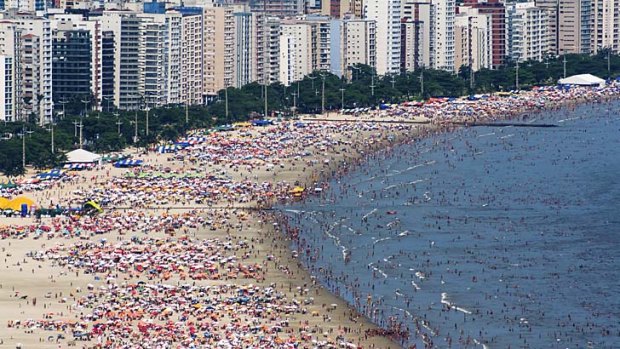
Seaside escape ... Santos near Sao Paulo.Credit: Getty Images
2 Smooth travel
Plagued by traffic, with a metropolitan area three times larger than Paris and a population of 20 million, Sao Paulo can be a nightmare to navigate. Fortunately, it has a half-decent subway. Launched in 1974 and recently extended, the mostly subterranean Metro rail network has five colour-coded lines that cover the city's most intriguing areas. (The massive Tiete bus terminal is a gateway to destinations across Brazil and beyond.) Brisk and inexpensive - three real ($1.40) a ride - the Metro is best avoided during rush hour, especially if you're carrying luggage. Crowded is an understatement.
3 Cafe culture
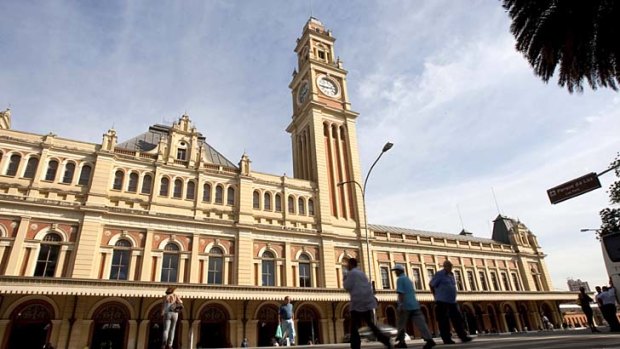
Estacao Julio Prestes ... Luz, Sao PauloCredit: Getty Images
Many foreigners came to work on the coffee farms that sprouted on Sao Paulo's verdant outskirts in the late 19th century. Now the world's largest coffee producer, Brazil exports about 25 million bags annually, which is six times more than South American neighbour Colombia. Punchy caffeine hits can be had in Sampa's many down-to-earth cantinas (which also rustle up snacks and tropical juices), and a growing number of plush, airconditioned cafes with award-winning baristas. Heaps of paulistanos (Sampa residents) swear by Cafe Floresta in the striking, S-shaped Edificio Copan, built by renowned Brazilian architect Oscar Niemeyer. cafefloresta.com.br.
4 Big Apple flavours
Strolling beneath Sampa's myriad skyscrapers, many with art deco flourishes, while hearing the honks of gridlocked taxis, you will appreciate why the city is known as the New York of South America. Modelled on the Empire State Building, the 161-metre-high Edificio Banespa has great views from the observation deck on the 36th floor. Another top vantage point is the rooftop restaurant and lounge bar of Edificio Italia.
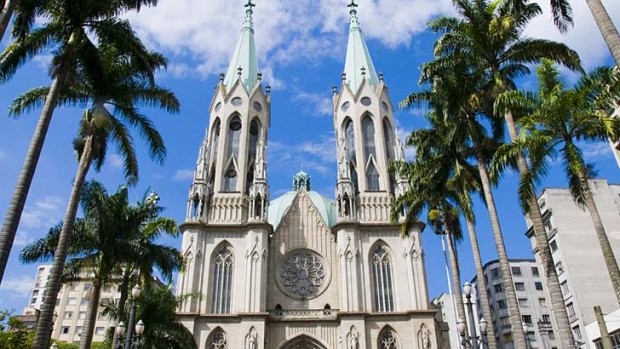
Se Cathedral in downtown Sao Paulo.Credit: Getty Images
5 Multiculturalism
The city's first skyscraper, Edificio Martinelli, was built by Giuseppe Martinelli, one of the thousands of Italians seduced by a new life in Brazil. Like the Big Apple, Sao Paulo is a melting pot. The Italian flavours are particularly strong in the cafe-and-pizzeria-packed zone of Bixiga (also known as Bela Vista). There's a Jewish diaspora - and synagogues - in affluent Higienopolis and Consolacao, and a strong Arab and Turkish feel courses along Rua 25 de Marco, which is a hive of kebab shops, bargain stores and bootleg stalls. The city is also shaped by eastern European, African, Spanish and, of course, Portuguese influences. Brazil was colonised by Lisbon's emperors until 1822.
6 Little Japan
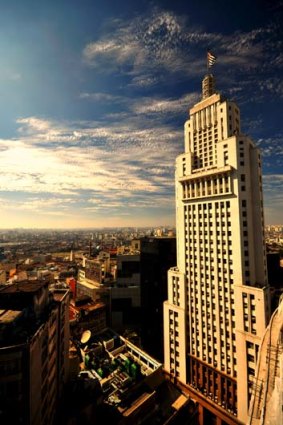
Skyscraper ... Edificio Banespa, Sao Paulo.Credit: Getty Images
The most absorbing immigrant quarter, however, is Liberdade. Chinese and Koreans live here, but it's said to have the largest Japanese community outside Nippon. You'll see vermilion torii arches, lantern-like street lamps, sushi shops, ramen restaurants and plenty of Tokyo-style hairstyles and fashion victims. The district's Museum of Japanese Immigration explores Japanese-Brazilian heritage, and the weekly Sunday market on Praca de Liberdade has strong Asian vibes.
7 Centro
Its seeds planted by Jesuit priests in 1554, Sao Paulo's historic core is surprisingly walkable. Pedestrianised fingers spring off Praca da Se, a lively square studded with lofty palm trees and a huge neo-Gothic cathedral, whose interior is decorated with sculpted exotic fruits and animals. A block away, a pink-tinged 18th-century colonial mansion, Solar da Marquesa de Santos, shoulders Casa da Imagem, a new museum with archive photos charting Sampa's rapid growth from sleepy country town to international juggernaut. It's worth grabbing a map from the tourist information centre. 473 Avenida Sao Joao, near Praca da Republica.
8 Jardins
The smell of roasted coffee also drifts from Santo Grao, a gourmet cafe on Rua Oscar Freire. Likened to Fifth Avenue in New York, this affluent, tree-lined shopping street runs through the wealthy Jardins neighbourhood (itself comprising the smaller leafy enclaves of Jardim America, Jardim Europa and Jardim Paulista). Catering to Sampa's rich and beautiful, Jardins parades designer stores, swanky villas, cocktail and jazz bars and top-end eateries such as D.O.M., where Brazilian super-chef Alex Atala crafts fusion dishes spiked with native ingredients such as Amazonian fruits and manioc (Brazilian couscous). domrestaurante.com.br.
9 Avenida Paulista
Slicing between Bixiga and Jardins, Avenida Paulista is Sao Paulo's main business artery, a three-kilometre stretch hedged by banks, bombastic high-rises, upscale malls, theatres and other notable sights, such as a gold-domed cathedral. Oozing old-fashioned charm, Casas das Rosas (35 Avenida Paulista) is one of the few remaining art nouveau-style mansions built by the coffee barons. It's now an arts and poetry centre with revolving exhibitions and a lovely rose garden.
10 Ibirapuera Park
The Biennial is held in Sampa's greatest green lung. Perfect for escaping the traffic and noise, the park has a lake, monuments, sculptures, pavilions, eye-catching buildings designed by Oscar Niemeyer and two contemporary art museums (MAM and MAC). The park's Museu Afro-Brazilian reflects on slavery - which Brazil finally abolished in 1888 (half a century after the British Empire did) - and the art, religions and culture of one of Brazil's most vibrant communities.
11 World-class art
Also on Avenida Paulista, Sampa's premier art museum, MASP, stands on four red stilts. Its galleries stock what's claimed to be the best collection of Western art in the southern hemisphere. It also showcases renowned Brazilian artist Candido Portinari, whose paintings are inspired by his humble background (he was born on a coffee plantation in Sao Paulo state). Founded in 1951, the Sao Paulo Biennial is one of the art world's most prestigious gatherings, drawing artists and curators (and their work) from around the globe. This year, it's from September 7 until December 9. bienal.org.br.
12 Lavish sleeps
The talents of Sao Paulo's top designers fuel the city's most luxurious crash pads. The Emiliano (emiliano.com.br) and Fasano (fasano.com.br) hotels offer five-star style and service, the former with its own rooftop helipad. Another lavish $500-plus-a-night option, the watermelon-shaped Unique Hotel - with its fancy Skye Bar - is the brainchild of Japanese-Brazilian architect Ruy Ohtake.
13 Boutique on a budget
Sao Paulo is a pricey city, but it's possible to bed down in comfort without breaking the bank. Decent budget choices abound in Vila Madalena, a hip, bohemian area packed with galleries and bars where foreigners and locals mingle over Caipirinhas. Doubles at the Vila Madalena Hostel cost from 140 real. vilamadalenahostel .com. In the neighbouring Pinheiros district, a stone's throw from the Instituto Tomie Ohtake, the trendy CityLights hostel opened its doors in July. Doubles $68. facebook.com/citylightshostel.
14 Itaim Bibi and Vila Olimpia
From Pinheiros, the Avenida Brigadeiro Faria Lima, dotted with malls and boutiques, runs down to two of Sampa's most chic districts. Itaim Bibi and Vila Olimpia have slick bars, high-end clubs (with 100-real cover charges) and superb restaurants, with everything from traditional Brazilian churrascarias (steakhouses) to sophisticated choices such as Kaa, which is home to lush hanging gardens and a menu that blends European and South American flavours. kaarestaurante.com.br.
15 Mercado Municipal
For a more frenetic and aromatic dining scene, hungry masses flock to this revamped indoor market, set in a neo-baroque building etched with stained-glass windows of bucolic, bygone Sao Paulo milieus. Alongside DVD and clothes stalls, fresh produce markets sell fruits, vegetables, fish and cheeses. There are also good sit-down restaurants and snack bars such as Hocca, whose signature dish is salted cod pastries. mercadomunicipal.com.br.
16 Luz
Though still scrappy in parts - with a visible homeless population - this key Metro interchange and former red-light district has been spruced up and boasts fine cultural attractions. The Pinacoteca do Estado exposes Brazilian art from the 19th century to the modern era, while the great hall of Estacao Julio Prestes, one of two elegant old railway stations in the Luz neighbourhood, has been transformed into Sala Sao Paulo, a 1500-seat concert hall that hosts the state's symphony orchestra.
17 Football
The son of a Sampa-based British railway worker, Charles Miller, is credited with introducing football to Brazil. Learn more about him, and the way the sport became a national obsession for Brazilians, rich and poor, in the excellent Museu do Futebol. Packed with family-friendly interactive exhibits, it's in Estadio do Pacaembu, home of Corinthians, one of Brazil's oldest football clubs.
18 Campos do Jordao
Sao Paulo can get horribly humid, especially in summer. A pleasant and popular retreat for paulistanos is the mountain resort town of Campos do Jordao, which is soaked with Swiss and German influences, owing to the heritage of its early immigrants. Go hiking, cycling or mountain climbing, savour fondue and hot chocolate and bed down in deluxe alpine-tinged chalets. camposdojordao.com.br.
19 Theatre
Sao Paulo has arguably South America's leading twilight cultural scene, with an estimated 150 theatre and performance spaces. Designed like the Paris Opera House and lit up gloriously at night, the beautiful Teatro Municipal melds art nouveau and Renaissance styles with aplomb. For Sampa's cultural events listings, see cidadedesaopaulo.com.
20 Seaside escapes
An alternative is to hit the beach. Sao Paulo is 80 kilometres from the energetic port city of Santos. Enticing stretches of sand, from jam-packed, condo-lined haunts to rustic fishing villages, spring off in both directions. Off the Litoral Norte (North Shore), the island of Ilhabela tempts with its pristine beaches, jungly waterfalls and sublime seafood.
Sign up for the Traveller Deals newsletter
Get exclusive travel deals delivered straight to your inbox. Sign up now.